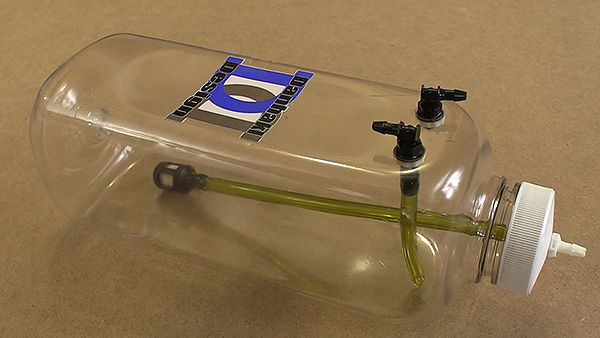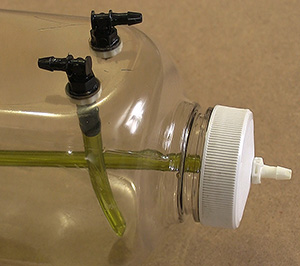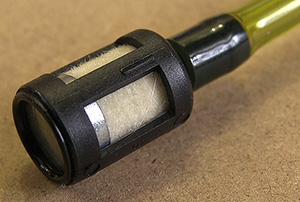



If you want a fuel tank that is light, easy to set up and works as expected, the
Fortitude tanks just might be what you are looking for.
Text, photos and video by Tom Hintz
Flight video by Clark Ponthier
Posted - 2-5-2015
The world of RC flying progressed a bunch in the 25 years I was away. Included in the updated technology was some new thinking on the fuel tanks in our planes. When I made the jump from electric to gasoline power plants I also had to pick a tank. The milky white plastic tanks from 25 years ago remain in use, many with subtle updates but I also noticed some radically new offerings. The Fortitude Gas Tanks is just one of the new lines that caught my attention.
One of the interesting things about the Fortitude Gas Tanks is that they were designed by Jason Danhakl a long time modeler and competitive flier that is also familiar with product design/ development. I liked the idea of an experienced RC’r with real-world first-hand experience designing fuel (and smoke) tanks. Also, Fortitude R/C LLC is based in San Antonio, TX and manufactures all of their products in the USA.
Fortitude Gas Tanks are made from a tough crystal clear plastic that provides an unobstructed view of the tanks innards so we can see debris or a clunk-related problem. Fortitude claims their tanks are the lightest weight RC fuel tanks that are commercially available. They say that the Fortitude Gas Tanks can be up to half the weight of the older molded plastic tanks and I have not been able to find anything to refute those claims.

Simple, secure tank fittings.
Fortitude Gas Tanks come all set up with a three line configuration – a line directly to the carb, a separate vent line and an independent filling line that can be run to a fuel dot. Many like this configuration because filling the tank puts no direct pressure on the carb line. Fortitude Gas Tanks come with a filtered clunk. It should be noted that Fortitude Gas Tanks makes special smoke tanks because the filtered clunk will not work with smoke fluids which are typically much thicker than fuels.
Note: If you want to combine the carb and filler lines you can plug the extra port on the tank.
The seamless tank comes with all of the fittings and internal lines factory installed. The screw on cap is factory sealed using an Aerospace Mil spec sealant. This style cap is important because it replaces the old style rubber plug that expands outward to create a seal. That also put pressure on the plastic seamed tanks and occasionally helped split the tank. You also get a piece of foam padding on which to mount the tank and a length of hook and loop strap for securing the Fortitude Gas Tanks in your plane.
Fortitude Gas Tanks are square shaped to fit in more of today’s crowded fuselages. The 16 ounce tank is 7”-long by 2.5”-wide and 2.5”-tall and weighs just 1.5 ounces. Currently Fortitude Gas Tanks are available in four sizes 8, 12, 16, and 32 fluid ounces. Noticeably absent is a 24-ounce size but Fortitude is considering adding that size to their lineup. Because they do not use an existing “bottle” another size tank means a whole separate mold system which is not a cheap deal.
One of the questions I have seen regarding Fortitude Gas Tanks is why the clunk is set away from the back of the tank a bit. Fortitude says because all fuel line expands when in contact with fuel the clunk is set a little farther forward to make sure that the final position is correct. Also they use a special filtered clunk that draws fuel around the sides and not from the end. The felt-like material works like a sponge allowing it to literally draw out all of the fuel. I have run a Fortitude Gas Tank dry (accidentally) and it really was all but dry. The inside of the tank was wet but that was the extent of the remaining fuel!
Another common concern is the lack of safety wire securing the tubing to the fittings inside of the Fortitude Gas Tanks. Fortitude says the size and shape of the barbs molded into the fittings is more than adequate to secure tubing without additional restraints. I have absolutely no evidence that suggests lines will fall off of Fortitude Gas Tank fittings but I always add a small tie wrap at all external fittings on these and any other tanks I use. Color me careful or obsessed, whatever works for you.

This clunk is super efficient at picking
up even small amounts of fuel.
With the internal plumbing completed at the factory all that is left for us is to install the Fortitude Gas Tanks in our panes and string the fuel tubing as needed for that application. I used the foam padding and strapping included with the Fortitude Gas Tank but I did use DuBro Tygon fuel line. I also put a Sullivan Crap Trap in the line before the carb as a final defense against junk and to help break up bubbles that might come along.
I do look at the tank before I install the canopy but through most of a flying season now the Fortitude Gas Tank just keeps doing its job. It hasn’t moved, keeps delivering fuel as the engine needs it and doesn’t seem to care if the plane is upright, knife edge, inverted or tumbling.
There was one occasion when my plane unexpectedly ran out of fuel and went dead stick on me. The Fortitude Gas Tanks did not refill itself between flights nor did it remind me to fill it up. If you will accept the premise that is the only thing the Fortitude Gas Tank did wrong. For those who remain clear thinking the refilling issue was my fault and the Fortitude Gas Tank has not done anything wrong that I can find. It also shows no sign that it will do anything wrong in the foreseeable future.
I was a big fan of plug-n-play when it came to computers and the Fortitude Gas Tanks are essentially the same thing in the RC world. Not having to assemble the tanks eliminates an opportunity for us to mess something up. The quality of the Fortitude Gas Tanks and their components means we can install them and pretty much forget them for way longer than with traditional tanks. They even include quality fuel line to help you complete the installation.
Good stuff is never cheap but Fortitude Gas Tanks come closer than I expected. A 16oz Fortitude Gas Tank (# FORS1010) with mounting foam, straps and fuel line sells for $21.99. (2-4-2015) A 32oz version runs about $24.95 with the same components. You can also buy smoke and fuel tank packages that come the tanks mounted on a tray and save a few more bucks.
If you need a gas tank take a look at the Fortitude Gas Tanks. Between the peace of mind and low maintenance demands and your flying just might get a little more fun.
Visit the Fortitude Gas Tank web site – Click Here
I get all my Fortitude tanks (and nearly everything else) at Anderson RC
Have a comment on this review? - Email Me!